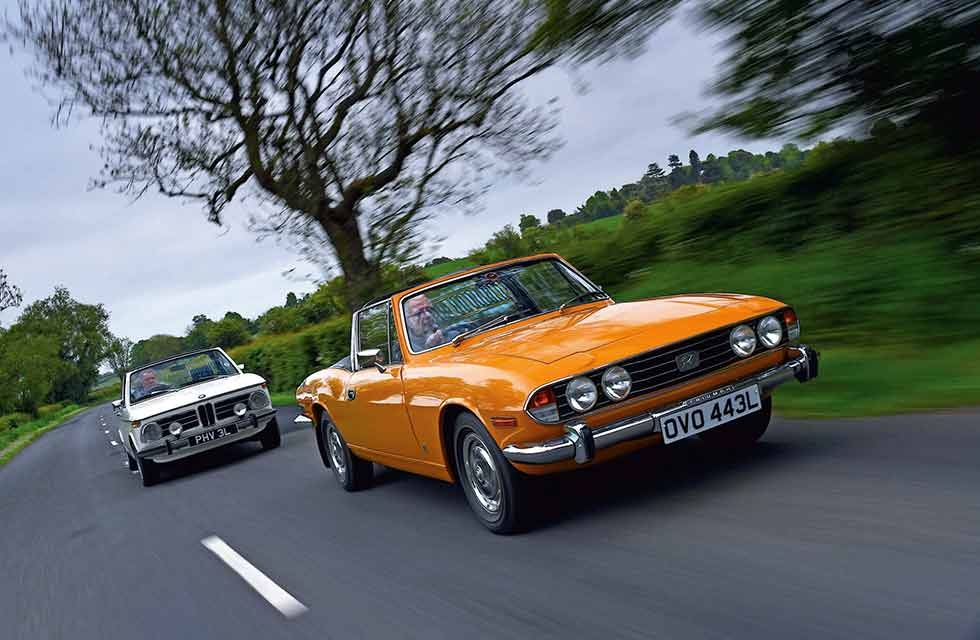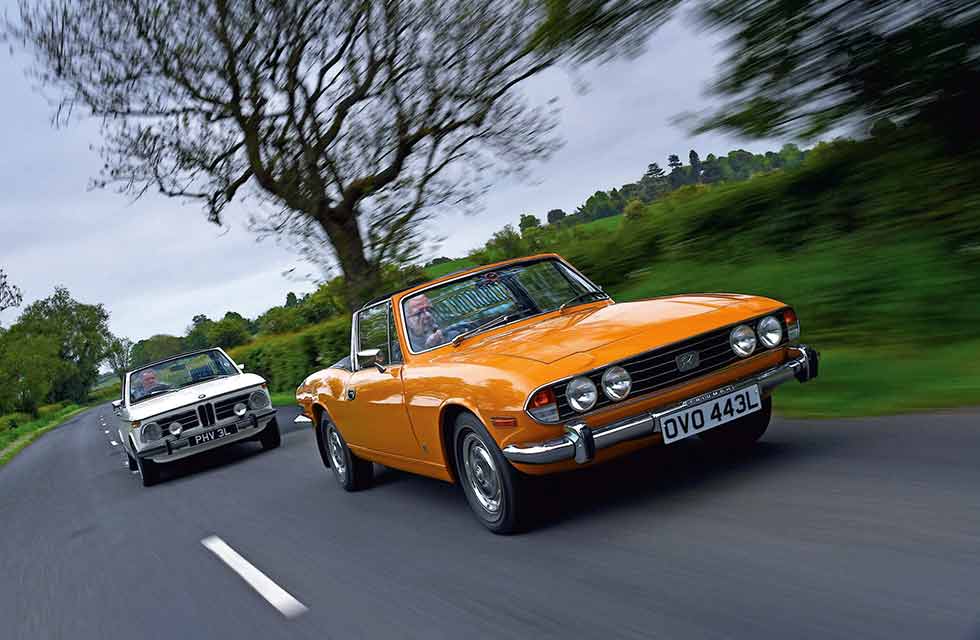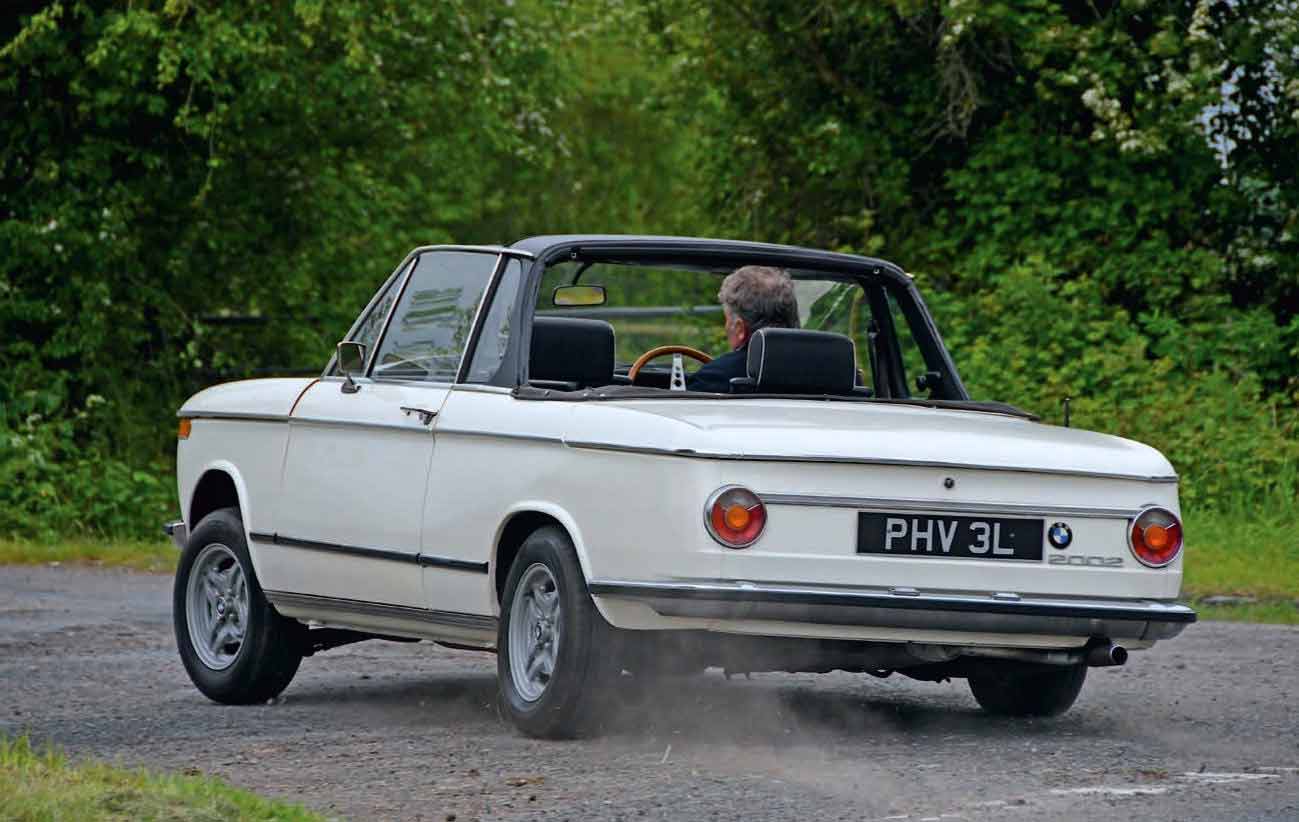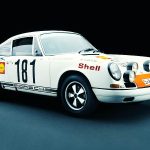
Fun fare for the family man Triumph vs. BMW. Can the much-maligned Stag match up to the Ultimate Driving Machine 2002? The BMW 2002 Cabriolet and Triumph Stag prove that having kids need not mean an end to soft-top motoring. Words Martin Buckley. Photography John Bradshaw.
OPEN TOP FAMILY FUN: TRIUMPH STAG vs. BMW
Feeling stressed? Forget the yoga and the pilates, and get yourself a Triumph Stag. It’s the burble that does it. Obviously V8 in its alternating beat – but somehow a sound very particular to this often unfairly maligned but much-loved 2+2 – it strikes a note of cultivated machismo that suits the Stag’s laid-back personality perfectly. This is a car to suppress the most aggressive tendencies in any driver. Yes, a Stag goes quite well when roused – it is, after all, a 3-litre, near-120mph grand tourer – but rarely are they driven anything other than sedately.

That observation says a lot about the car, for this is not a vehicle to ignite competitive instincts. You just waft, emanating a sense of well-being that would probably come across as smug in any one of the Stag’s many modern ‘lifestyle’ drophead successors. The difference, almost 50 years ago, was that the Stag didn’t have many rivals if you were after a four-place open car with V8 power, suave Italian looks and winter headgear substantial enough to transform it into a cosy GT when the nights began to draw in.
‘The Stag rolls somewhat when pressed, but has ample grip and can be urged through a series of bends with satisfaction’
In fact, for just over £2000 in late 1970 there was nothing like it. The ageing Mercedes-Benz 280SL W113 cost more than twice the money (and didn’t even pretend to have rear seats), while more comparably priced closed-roof supposed competitors such as the Alfa-Romeo 1750 GTV and Lotus Elan +2S had nothing like the Triumph’s versatility.

The story of the Stag is, of course, a well-known tale of woe. Conceived in the mid-’60s on the say-so of Canley engineering boss Harry Webster, it sold to the tune of just under 26,000 cars through to 1977. Underdeveloped mechanically, it fell victim to boardroom wrangling and associated distractions of the newly formed British Leyland. When Webster moved to the Austin Morris division to oversee development of the Marina, the fate of his creation was sealed: as an expensive and troublesome curiosity in the BL range the Stag was doomed, particularly once the infamous overheating problems associated with the high-mounted, gear-driven water pump became common knowledge.
‘Even in Cabriolet form the 2002 feels feisty; it begs to be thrown about and feels entirely rigid and confidence-inspiring’
Thus tainted, the car had no future in the North American market it was intended for and was so obviously suited to, and most Stags stayed in the UK. Here it has always had a healthy fanbase, however, and remains the most ‘clubable’ of cars that even once held the honour of being the UK’s most stolen classic.
Obsessed with the success of the Mercedes ‘Pagoda’, Webster sold the idea of a larger, more luxurious open Triumph to his boardroom superiors on the basis that it would be cheap to develop; essentially a reskinned 2000, using the same running gear and suspension on a shortened version of the same floorpan. The initial plan was to use the saloon’s 2.5-litre injected straight-six, too, but the Stag came to be defined by a new V8, the senior member of a series of modular four-, six- and eight-cylinder overhead-cam engines that were already too far down the pipeline when the Leyland merger happened.
The first specification was for a 2.5-litre V8 with fuel injection, but given its troubled history it is perhaps just as well that it emerged as a very oversquare 3-litre on a pair of Strombergs, good for a rather conservative 145bhp.

As the author of every Triumph body since the Herald, Giovanni Michelotti was naturally engaged to do the shape: a handsome 2+2 with curved hips that came together quite quickly once ideas of hidden headlights and a powered hood had been discarded. A stylish launch campaign pushed the Stag’s credentials as a sophisticated grand-touring car with international appeal – and understandably said nothing about the problems Triumph engineers had faced in getting the V8 to fit where it didn’t want to go, while negotiating ever-changing federal rules on crash safety and emissions.
From a distance, it looked as effortless as the BMW 2002 Cabriolet (launched the following year) appeared clunky and contrived. Announced originally as the fully open Baur 1600 Cabriolet in 1967, it re-emerged in 2-litre form in 1971 – complete with a targa-style roof that added 110lb to the weight and £1000 to the price when the first of the 354 right-hookers arrived in the UK in February 1973. In fact, at £3499 including taxes, the 2002 Cabriolet was the most expensive of the small two-door BMW family other than the turbo, and nearly £900 more than a Stag.
It was a car in a tradition of Baur-built open four-seater BMWs going back to the 320 and 326 cabrios of the ’30s. Formed in 1910 in Stuttgart, Baur also did open versions of the 501/502 – and made the M1 bodies – but it wasn’t until the 700 Cabriolet that the firm got into a volume relationship with BMW that lasted until the 1980s and the E21 and E30 3-Series Top cabriolet.
The 2002s were produced at the rate of 500 a year, using parts supplied by BMW, and offered through to June 1975, but only in 2-litre, 98bhp single-carb form. The most significant option was a ZF automatic transmission, but UK buyers got locally made four-spoke alloys to sweeten the deal. It was never BMW’s intention to take on the world with these cars but, by farming out the work, it could satisfy the limited appetite for an open car without upsetting the flow of its regular production line. Total Baur ’02 output was 4210, of which 1682 were the original (and allegedly not very rigid) full open model of 1967-’1971.
Where the standard tin-top has a purposefully boxy, tenacious look, the 2002 Cabriolet seems to have too much back end and not enough glass. It is one of those rare things: a droptop that is much more handsome with its roof in place. This 1973 ‘round light’ car has been owned by Tim Callaghan for 11 years, during which time he has had the engine rebuilt and fitted a new bonnet. It is telling, perhaps, that Callaghan is the 15th owner. He is fond of the Baur, and uses it regularly, but freely admits that he prefers his 3.0 CSi E9. “My wife hates the car,” he says. “It’s a bit of a ‘girl’s car’, but very reliable; I can leave it for months and it always starts straight away.”
Like the Stag, its rear seats are of the generous ‘+2’ variety rather than promising long-distance comfort for anybody older than 10 years. You can run it as a ‘coupe de ville’ with the roof panel stored on special clips in the boot, or all open with the rear section folded flush into the body. The door glasses are frameless, but the rollbar is afforded additional support by rails that link it to the windscreen frame, which is good for structural rigidity if not for the looks.
The hefty clamshell bonnet is front-hinged and opens to reveal an aftermarket strut brace, dual ATE servos and the canted-over in-line ‘four’ that is one of the cornerstones of BMW’s post-war success. Compact and efficient, refined yet responsive, even in this modest single-Solex-equipped form it gives gutsy performance to match the 3-litre Stag if you are willing to stir its manual gearbox enthusiastically enough. But first get comfy behind the three-dial instrument pod, fumble with the heater slide controls on each side of the steering column (for warm feet in top-down mode) and remind yourself that BMW built its reputation for producing cars that pleased their drivers by thinking long and hard about seat, steering and pedal positions, and their solid, evenly weighted action.
A distinctively wheezy starter motor gives life to an engine that idles smoothly and near silently but will rev to 6000rpm-plus with a well-bred whine of its camshaft chain. With virtually 100bhp per ton in saloon form, the 2002 was a revelation in ’68 and was one of the great driver’s cars of the decade. You can conduct it sedately with great pleasure thanks to a flat torque curve and accurate manual steering that gives a good lock and only feels heavy at low speeds if you are used to pedalling modern cars.
Even in Cabriolet form it feels a feisty entity when extended. The short, smooth action of the lever and progressive, positive clutch bite allow you to revel in changing gear, blessing the close stacking of the ratios as you gun this wholesome, enthusiastic little car along. It begs to be thrown about just like any other 2002 and feels entirely rigid and confidence-inspiring. It’s stable in corners – but not so much that it doesn’t respond – and with a sense that you know exactly what all four wheels are doing through your hands and backside. The brakes are superb, the lovely firm pedal making a nice fulcrum for heel-and-toeing, and as long as the squeaky roof panel is removed there are no appreciable creaks or rattles on suspension that is resilient yet supple. Superficially, Paul Catterall’s Mk1 Stag automatic is a more appealing car than the BMW, particularly in the Saffron yellow redolent of the Triumph’s fleeting appearance in Diamonds are Forever. It has the early wheeltrims, BL badges on the front wings, and is bereft of the headrests and body stripes that were MkII features.
This beautiful, one-previous-owner car is correct in all its details, right down to the radio. “I bought the Stag to replace a Morris Minor Convertible – having measured the garage first – in 2004,” says Catterall. “It’s totally standard with no upgrades – not even a larger radiator.” With its central T-bar, the Stag has probably the most stylishly resolved roll hoop of any car you will find plus a great rear end with those big, aggressively angled double-barrel tailpipes.
The Triumph is narrow for its length and seems no more roomy than the shorter BMW. It also has a much smaller boot. In fact, it feels as if you are sitting on the Stag rather in it with its shallow footwells. Still, the vinyl seats are more comfortable than the BMW’s hard chairs and the controls rather more comprehensive – Triumph led the way in the early ’70s in its use of fingertip stalks and warning lights. Nothing is quite as pleasing to the eye – or the touch – as the minimalist German car, though, even if you do get electric windows, an adjustable steering column and a tilting seat mechanism, items not even available as options in the austere BMW.
Put the dinky ‘T’ selector into Drive and the Stag rumbles away amiably, with gearchanges that are smooth enough but delayed sufficiently that you can’t help but try to anticipate them in the change of engine note. Being an auto it is low-geared overall for modern motorway cruising, but has acceleration not dissimilar to the manual version. A responsive mid-range kickdown gives the Stag a reasonably lively character. For many, the benefits of light steering at parking speeds will outweigh any concerns about lack of feel or feedback. True, the Stag rolls somewhat when pressed, but it has ample grip, does not wallow, float or pitch, and can be urged through a series of bends with satisfaction as long as you don’t ask it to carry too much speed in the bumpy corners where the BMW excels.
The shell seems every bit as stiff as the 2002’s, the ride very acceptable. But as a car to drive quickly and well, the Stag can’t offer the rewards of the BMW because it does not engage with the driver in the same manner – ways that are easy to feel but hard to define. In fairness, it was never intended to be that sort of car, and had its creators got the engine right most buyers would have been more than willing to overlook minor shortcomings in the finer points of its handling. Had it sold in sufficient numbers, doubtless Triumph would have seen the benefits in sorting the rest of the car, the basics of which were sound.
At a time when the European motor industry was second-guessing US legislators on the very future of convertibles, the Stag seemed like a brave project, although given Triumph’s success in selling TRs and Spitfires to the Americans it was probably seen as risk worth taking. The tragedy of the Stag is that it was a clever and attractively packaged concept that should have cleaned up against the overpriced German opposition. Nice as it is to drive, the 2002 is a hard car to warm to visually, an oddity and a curiosity compared to the glamorous Triumph.
I don’t love Stags and will never own one, but I’m happy they exist. There is something slightly louche about them, and the passage of time has made their problems seem more like legend than fact. That you still see so many says a lot for the enduring appeal of a car that makes a much better classic than it did a current model. In short, a car with a feelgood factor that transcends its shortcomings, real or perceived.
TRIUMPH STAG
Sold/number built 1970-’1977/25,939
Construction steel monocoque
Engine all-alloy, sohc-per-bank 2997cc V8, twin Zenith-Stromberg carburettors
Max power 145bhp @ 5500rpm
Max torque 170lb ft @ 3500rpm
Transmission four-speed manual with overdrive or three-speed automatic, RWD
Suspension independent, at front by MacPherson struts, anti-roll bar rear semitrailing arms, coil springs, telescopic dampers
Steering power-assisted rack and pinion
Brakes discs front, drums rear, with servo
Length 14ft 6in (4420mm)
Width 5ft 4in (1626mm)
Height 4ft 2in (1270mm)
Wheelbase 8ft 4in (2540mm)
Weight 2807lb (1273kg)
0-60mph 9.5 secs
Top speed 118mph
Mpg 20
Price new £2616 (1973)
Now £10-25,000
Thanks to The Stag Owners Club (www.stag.org.uk)
{module Triumph Stag}
Clockwise from main: Michelotti shape was a chic take on the family look; twin pipes emit a cultured burble; notorious 3-litre V8; handling is on the soft side of sporting; comfy cabin. Opposite: owner Paul Catterall acquired the Stag in ’04.
BMW 2002 CABRIOLET
Sold/number built 1971-’1974/2713
Construction steel monocoque
Engine iron-block, alloy-head, sohc 1990cc ‘four’, single Solex 40PDSI carburettor
Max power 98bhp @ 5500rpm
Max torque 116lb ft @ 3000rpm
Transmission four-speed manual, RWD
Suspension independent, at front by MacPherson struts, anti-roll bar rear semitrailing arms, coil springs, telescopic dampers
Steering ZF worm and roller
Brakes discs front, drums rear, twin servos
Length 14ft 2in (4318mm)
Width 5ft 2 ½ in (1588mm)
Height 4ft 5 ½ in (1359mm)
Wheelbase 8ft 2 ½ in (2500mm)
Weight 2337lb (1060kg)
0-60mph 10.8 secs
Top speed 106mph
Mpg 28
Price new £3499 (1973)
Now £15-25,000
Thanks to Richard Stern, BMW Car Club GB 02 Register (bmwcarclubgb.uk)
{module BMW New Class}
Clockwise from main: ’02 corners with real agility; 100+ alloys were a UK staple; carb-fed 2-litre was the only option for Cabrio; substantial hoop incorporates windows; aftermarket wheel and piped seats. Opposite: owner Tim Callaghan.







